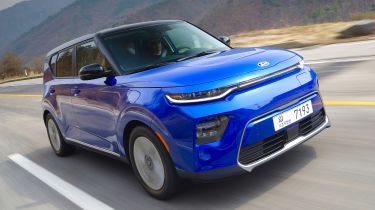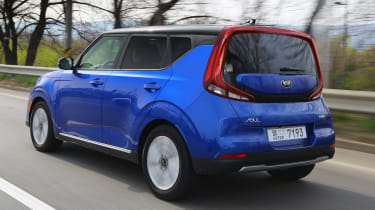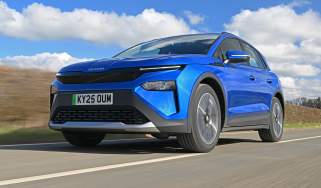New Kia Soul EV review
The Kia Soul EV follows in the footsteps of the brilliant e-Niro, and delivers almost as much in a cheaper package

| Car type | Range | Wallbox charge | Rapid charge |
|---|---|---|---|
| Electric | 280 miles | 9 hours | 1 hour 15 mins |
While many manufacturers are still scrambling to build their first electric cars, Kia has just delivered its third: the new, second-generation Soul EV.
Replacing the previous Soul EV – which was launched in 2014 – the new model sits underneath the e-Niro in Kia’s electric range. Both cars use the same 64kWh battery and 201bhp electric motor, and return a very similar 280-mile range in real-world conditions.
To this end, Kia has installed a battery heating system to improve the cells’ performance in cold weather. A heat pump also aids efficiency, and the clever air-conditioning directs air only to where it’s needed.
The Soul EV’s charging port can be found at the front end, and a full charge from flat will take around nine hours on a home wallbox charger. However, on a 50kW rapid charger – the like of which you’ll find at a motorway service station – a 0-80% top-up will take a mere 75 minutes. The Soul EV is compatible with both AC and DC chargers.
On the move, the electric motor returns the kind of performance a hot hatchback would be proud of: 0-62mph takes 7.9 seconds, and the Soul EV feels even faster from 0-30mph on urban roads. The front wheels struggled for grip once or twice when we were extra-aggressive with the accelerator, but this will rarely pose a problem for most drivers.
While the acceleration is fun, the Soul EV falls short with its steering, which feels too light and forced us to make lots of small corrections on the go. This improves when switching from Normal to Sport mode, but the extra weight gained here feels artificial. We’re hoping Kia will fine-tune the settings before the Soul EV arrives in the UK later in 2019.
Most electric cars suffer from a firm ride caused by the weight of their batteries, and the Soul EV is no different: bumps and rough road surfaces take their toll, but it’s far from harsh enough to be called uncomfortable.
Normal and Sport modes are joined by Eco and Eco+ settings, with the latter designed to extract the maximum possible range by turning up the regenerative braking and switching off the air-conditioning. You can adjust the level of regenerative braking to your liking, too, with paddles either side of the wheel: the harshest setting will bring the Soul EV to a complete stop without touching the brake pedal.
On our test route in South Korea, we were pleased to see the range dropping in line with the mileage we covered – both around town and on motorways – and we even saw the range rise with use of the regenerative braking system on downhill stretches. This bodes well for its arrival in the UK.
As does its new look: the previous generation of the Soul EV turned a lot of people off with its boxy proportions, but this new car features softer edges and a longer, sleeker profile. The LED front headlights, wraparound tail-lights, 17-inch alloy wheels and chrome detailing on the front end all add to the more stylish appearance.
Inside, Kia’s upmarket ambitions are evident with the 10.25-inch infotainment screen and soft-touch plastic panels on the dashboard and on the doors. All of the buttons and knobs are good to touch, and crucially feel well built enough to last at least as long as Kia’s standard seven-year warranty.
There’s lots of technology on board, with a seven-inch digital instrument cluster behind the steering wheel, plus a head-up display so drivers don’t need to avert their gaze from the road while driving. Meanwhile, safety features include 'level two' autonomous driving, which will keep the Soul EV in its lane and a set distance from the car ahead on the motorway.
Smartphone connectivity is provided in the form of Android Auto and Apple CarPlay, with wireless phone charging available as well.
A Harman Kardon audio system is standard, and the interior mood lighting can be configured to pulse to the rhythm of your music. And by downloading the Kia UVO app you’ll be able to adjust the climate control remotely, as well as keep an eye on charging progress while the Soul EV is plugged in.
There’s more space inside the new Soul EV than in the outgoing model, and rear passengers will be more than comfortable despite the rear headroom dropping slightly. The boot is bigger, too: there are 315 litres of space with the seats up – 34 litres more than before – and 1,339 litres with the seats down.
While the Soul EV shares much of its DNA with the e-Niro, it has a funkier character which should appeal to a more youthful audience. Kia hopes it'll be cheaper than the e-Niro, too: things could change between now and its UK launch at the end of the year, but the company hopes prices will start from less than £30,000, inclusive of the Government’s £3,500 plug-in car grant.
A cheaper alternative will be available in some markets in the form of a 39.2kWh version, delivering a range of 172 miles. Kia has yet to decide if that's coming to the UK, so watch this space.
Either way, the Soul EV is an excellent electric car that delivers almost everything the e-Niro – our 2019 Car of the Year – can in a more affordable package. Better still, with the e-Niro’s entire 2019 UK allocation accounted for, you’ll be able to buy the new Soul EV before its bigger sibling returns in 2020.



